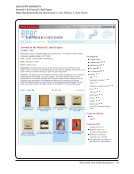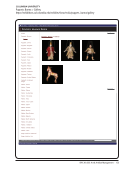SPEC Kit 333: Art &Artifact Management · 19
Survey Questions and Responses
The SPEC Survey on Art &Artifact Management was designed by Morag Boyd, Head, Special Collections
Cataloging, and Jenny Robb, curator, Billy Ireland Cartoon Library and Museum, at the Ohio State
University. These results are based on data submitted by 68 libraries at 53 of the 126 ARL member libraries
(42%) by the deadline of May 7, 2012. The survey’s introductory text and questions are reproduced below,
followed by the response data and selected comments from the respondents.
Research libraries and their parent institutions are increasingly highlighting special collections as the unique holdings that
differentiate libraries from one another. Often these collections of distinction contain art works, historical artifacts, and other objects
that are neither published works nor archival collections. Without clear protocols for management of these collections, libraries have
adopted a range of practices to ensure intellectual and physical control of these materials.
The purpose of this survey is to examine the extent to which art and artifact collections are held in ARL member libraries and the
tools and techniques libraries have adopted to arrange and describe these objects. The survey findings will assist libraries in shaping
their strategy for managing art and artifact collections, increasing their ability to care for these unique materials, and fulfilling
their stewardship responsibilities. By exposing the extent and type of these collections and examining the management of these
collections, with a goal of advancing the development of better shared practices, the survey would help libraries provide more and
better access to art and artifact materials, including re-purposing metadata for digitization. The data may also help focus collection
development related to these collections, including opportunities for collaboration with other cultural heritage institutions.
Some libraries have multiple, distinct collections that may handle art and artifacts differently. So that we may get as complete an
understanding of current policy and practice as possible, we will accept separate responses from as many distinct units or collections
from an institution as wish to complete this survey. For example, an institution may have several separately managed or administered
units with art or artifact materials that may wish to answer independently, but it is not necessary to provide a response for each
collection within those units.
The main portion of this survey is divided into two sections: one focused on art and one on artifacts. In the first section, please
include art objects such as paintings, works on paper, prints, art photographs, sculpture, decorative arts, or graphic design. In the
second section, please include artifacts such as historic photographs, historic objects, material culture, merchandise, archeological
objects, natural history specimens, architectural drawings, designs, models, or costumes. Some objects in your collection could be
considered both a work of art and an artifact, so we ask that you use your judgment to decide which is the most appropriate section
based on your specific collection and your reasons for collecting the materials.
Survey Questions and Responses
The SPEC Survey on Art &Artifact Management was designed by Morag Boyd, Head, Special Collections
Cataloging, and Jenny Robb, curator, Billy Ireland Cartoon Library and Museum, at the Ohio State
University. These results are based on data submitted by 68 libraries at 53 of the 126 ARL member libraries
(42%) by the deadline of May 7, 2012. The survey’s introductory text and questions are reproduced below,
followed by the response data and selected comments from the respondents.
Research libraries and their parent institutions are increasingly highlighting special collections as the unique holdings that
differentiate libraries from one another. Often these collections of distinction contain art works, historical artifacts, and other objects
that are neither published works nor archival collections. Without clear protocols for management of these collections, libraries have
adopted a range of practices to ensure intellectual and physical control of these materials.
The purpose of this survey is to examine the extent to which art and artifact collections are held in ARL member libraries and the
tools and techniques libraries have adopted to arrange and describe these objects. The survey findings will assist libraries in shaping
their strategy for managing art and artifact collections, increasing their ability to care for these unique materials, and fulfilling
their stewardship responsibilities. By exposing the extent and type of these collections and examining the management of these
collections, with a goal of advancing the development of better shared practices, the survey would help libraries provide more and
better access to art and artifact materials, including re-purposing metadata for digitization. The data may also help focus collection
development related to these collections, including opportunities for collaboration with other cultural heritage institutions.
Some libraries have multiple, distinct collections that may handle art and artifacts differently. So that we may get as complete an
understanding of current policy and practice as possible, we will accept separate responses from as many distinct units or collections
from an institution as wish to complete this survey. For example, an institution may have several separately managed or administered
units with art or artifact materials that may wish to answer independently, but it is not necessary to provide a response for each
collection within those units.
The main portion of this survey is divided into two sections: one focused on art and one on artifacts. In the first section, please
include art objects such as paintings, works on paper, prints, art photographs, sculpture, decorative arts, or graphic design. In the
second section, please include artifacts such as historic photographs, historic objects, material culture, merchandise, archeological
objects, natural history specimens, architectural drawings, designs, models, or costumes. Some objects in your collection could be
considered both a work of art and an artifact, so we ask that you use your judgment to decide which is the most appropriate section
based on your specific collection and your reasons for collecting the materials.


















































































































































































